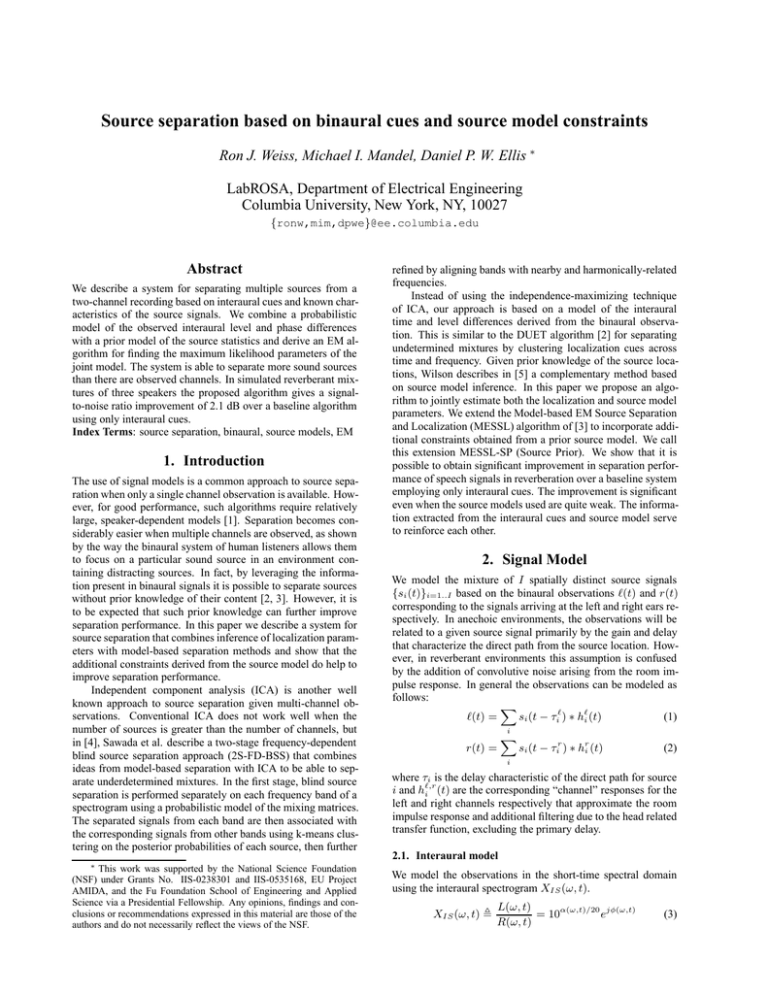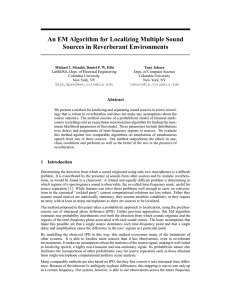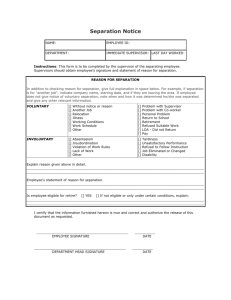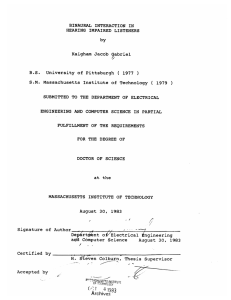Source separation based on binaural cues and source model constraints
advertisement

Source separation based on binaural cues and source model constraints
Ron J. Weiss, Michael I. Mandel, Daniel P. W. Ellis ∗
LabROSA, Department of Electrical Engineering
Columbia University, New York, NY, 10027
{ronw,mim,dpwe}@ee.columbia.edu
Abstract
We describe a system for separating multiple sources from a
two-channel recording based on interaural cues and known characteristics of the source signals. We combine a probabilistic
model of the observed interaural level and phase differences
with a prior model of the source statistics and derive an EM algorithm for finding the maximum likelihood parameters of the
joint model. The system is able to separate more sound sources
than there are observed channels. In simulated reverberant mixtures of three speakers the proposed algorithm gives a signalto-noise ratio improvement of 2.1 dB over a baseline algorithm
using only interaural cues.
Index Terms: source separation, binaural, source models, EM
1. Introduction
The use of signal models is a common approach to source separation when only a single channel observation is available. However, for good performance, such algorithms require relatively
large, speaker-dependent models [1]. Separation becomes considerably easier when multiple channels are observed, as shown
by the way the binaural system of human listeners allows them
to focus on a particular sound source in an environment containing distracting sources. In fact, by leveraging the information present in binaural signals it is possible to separate sources
without prior knowledge of their content [2, 3]. However, it is
to be expected that such prior knowledge can further improve
separation performance. In this paper we describe a system for
source separation that combines inference of localization parameters with model-based separation methods and show that the
additional constraints derived from the source model do help to
improve separation performance.
Independent component analysis (ICA) is another well
known approach to source separation given multi-channel observations. Conventional ICA does not work well when the
number of sources is greater than the number of channels, but
in [4], Sawada et al. describe a two-stage frequency-dependent
blind source separation approach (2S-FD-BSS) that combines
ideas from model-based separation with ICA to be able to separate underdetermined mixtures. In the first stage, blind source
separation is performed separately on each frequency band of a
spectrogram using a probabilistic model of the mixing matrices.
The separated signals from each band are then associated with
the corresponding signals from other bands using k-means clustering on the posterior probabilities of each source, then further
refined by aligning bands with nearby and harmonically-related
frequencies.
Instead of using the independence-maximizing technique
of ICA, our approach is based on a model of the interaural
time and level differences derived from the binaural observation. This is similar to the DUET algorithm [2] for separating
undetermined mixtures by clustering localization cues across
time and frequency. Given prior knowledge of the source locations, Wilson describes in [5] a complementary method based
on source model inference. In this paper we propose an algorithm to jointly estimate both the localization and source model
parameters. We extend the Model-based EM Source Separation
and Localization (MESSL) algorithm of [3] to incorporate additional constraints obtained from a prior source model. We call
this extension MESSL-SP (Source Prior). We show that it is
possible to obtain significant improvement in separation performance of speech signals in reverberation over a baseline system
employing only interaural cues. The improvement is significant
even when the source models used are quite weak. The information extracted from the interaural cues and source model serve
to reinforce each other.
2. Signal Model
We model the mixture of I spatially distinct source signals
{si (t)}i=1..I based on the binaural observations ℓ(t) and r(t)
corresponding to the signals arriving at the left and right ears respectively. In anechoic environments, the observations will be
related to a given source signal primarily by the gain and delay
that characterize the direct path from the source location. However, in reverberant environments this assumption is confused
by the addition of convolutive noise arising from the room impulse response. In general the observations can be modeled as
follows:
X
si (t − τiℓ ) ∗ hℓi (t)
(1)
ℓ(t) =
i
r(t) =
X
si (t − τir ) ∗ hri (t)
(2)
i
where τi is the delay characteristic of the direct path for source
i and hℓ,r
i (t) are the corresponding “channel” responses for the
left and right channels respectively that approximate the room
impulse response and additional filtering due to the head related
transfer function, excluding the primary delay.
2.1. Interaural model
∗
This work was supported by the National Science Foundation
(NSF) under Grants No. IIS-0238301 and IIS-0535168, EU Project
AMIDA, and the Fu Foundation School of Engineering and Applied
Science via a Presidential Fellowship. Any opinions, findings and conclusions or recommendations expressed in this material are those of the
authors and do not necessarily reflect the views of the NSF.
We model the observations in the short-time spectral domain
using the interaural spectrogram XIS (ω, t).
XIS (ω, t) ,
L(ω, t)
= 10α(ω,t)/20 ejφ(ω,t)
R(ω, t)
(3)
where L(ω, t) and R(ω, t) are the short-time Fourier transforms
of ℓ(t) and r(t), respectively. For a given time-frequency cell,
the interaural level difference (ILD) between the two channels
is α(ω, t), and φ(ω, t) is the corresponding interaural phase difference (IPD).
A key assumption in the MESSL signal model is that each
time-frequency point is dominated by a single source. This implies the following approximations for the observed ILD and
ITD:
α(ω, t) ≈ 20 log10
|Hiℓ (ω, t)|
|Hir (ω, t)|
φ(ω, t) ≈ ω(τiℓ − τir )
(5)
τ (ω, t)
c(ω, t)
φ(ω, t)
α(ω, t)
L̂(ω, t)
R̂(ω, t)
ω = 1..Ω
t = 1..T
σi
µi
ηi
hℓi
hri
(6)
where θ stands for the otherwise unspecified model parameters. Because φ(ω, t) is only observed modulo 2π, it is difficult to learn the IPD for a given source directly from the mixed
signal. To simplify this process, we define a grid of time differences τ to search over, and the IPD distribution for a given
source has the form of a Gaussian mixture model (GMM) with
one mixture component for each time difference on the grid:
P (φ(ω, t) | i, τ, θ) = N (φ(ω, t); ωτ, σi2 )
X
ψiτ P (φ(ω, t) | i, τ, θ)
P (φ(ω, t), i | θ) =
i(ω, t)
(4)
These variables have the advantage of being independent of the
source signal, so the resulting model does not depend on the
distribution of si (t).
We model the ILD for source i as a Gaussian distribution
whose mean and variance will be learned from the mixed signal:
P (α(ω, t) | i, θ) = N (α(ω, t); µi (ω), ηi2 (ω))
ψiτ
(7)
(8)
τ
Figure 1: MESSL-SP graphical model. Each time-frequency
point is explained by a source i, a delay τ , and a component c.
As the observed signal is likely to be small compared to the
amount of data needed to reliably train a prior signal model, we
use πic , ν ic and ς ic trained on clean data, and learn from the
mixture only the source-dependent channel and location parameters.
Combining the model of the interaural signals with the
source model gives the total likelihood of the model:
P (φ(ω,t), α(ω, t), L̂(ω, t), R̂(ω, t), i, τ, c | θ)
= P (i, τ ) P (φ(ω, t) | i, τ, θ) P (α(ω, t) | i, θ)
where ψiτ are the mixing weights for source i and delay τ .
2.2. Source model
P (c | i) P (L̂(ω, t) | i, c, θ) P (R̂(ω, t) | i, c, θ) (14)
We extend the baseline MESSL model described above to incorporate prior knowledge of the source statistics. This makes it
possible to model the binaural observations directly:
L̂(ω, t) ≈ Ŝi (ω, t) + Ĥiℓ (ω, t)
(9)
Ĥir (ω, t)
(10)
R̂(ω, t) ≈ Ŝi (ω, t) +
where X̂ , 20 log10 |X|. Each source Ŝi is modeled using a
GMM:
X
P (Ŝi (:, t)) =
πic N (Ŝi (:, t); ν ic , ς 2ic )
(11)
c
We assume that Ĥiℓ,r will be constant across the entire mixture
and that they will be relatively smooth across frequency. Therefore, we parametrize the channel response in the DCT domain,
giving Ĥiℓ (ω, t) = Bhℓi where B is a matrix of DCT basis vectors. This allows Ĥiℓ,r to be modeled using many fewer DCT
coefficients than the number of frequency bands Ω.
Combining this channel model with the source priors above
give the following likelihoods for the left and right channel spectrograms:
2
(ω)) (12)
P (L̂|i, c, θ) = N (L̂(ω, t); νic (ω) + B(ω,:)hℓi , ςic
2
P (R̂|i, c, θ) = N (R̂(ω, t); νic (ω) + B(ω,:)hri , ςic
(ω)) (13)
where B(ω, :) is the row of B corresponding to frequency ω.
This equation explains each time-frequency point of the mixed
signal as coming from a single source at a given delay and a
particular component in the source prior. The graphical model
corresponding to this factorization is shown in figure 1. For
conciseness we will drop the (ω, t) where convenient in the remainder of the paper.
3. Source Separation
If we knew which time-frequency points were responsible for
each source it would be trivial to separate them. But inference
of these posteriors requires knowledge of the unknown model
parameters θ ={ψiτ , σi , µi , η 2i , hℓi , hri }. To solve this problem
we derive an expectation-maximization algorithm to iteratively
learn the parameters and posteriors.
The E-step consists of evaluating the posterior responsibilities for each time-frequency point given the estimated parameters for iteration j, θj . We introduce a hidden variable representing the posterior of i, τ, c:
ziτ c (ω, t) = P
P (φ, α, L, R, i, τ, c, |θj )
P (φ, α, L, R, i, τ, c, |θj )
(15)
iτ c
The M-step consists of maximizing the expectation of the
total log-likelihood given the current parameters θj :
X
ziτ c (ω, t) log P (φ, α, L, R, i, τ, c|θ) (16)
Q(θ|θj ) =
ωt
As shown in (14), the log likelihood is factored into conditionally independent terms which can be maximized independently.
The updates for the ITD and ILD parameters are derived in
[6] and [3] respectively, but we reproduce them here for completeness. First, we define the operator
P
t,τ ziτ c (ω, t)x
hxit,τ , P
(17)
t,τ ziτ c (ω, t)
as the mean over the specified variables, t and τ in this case,
weighted by ziτ c (ω, t). The updates for the interaural parameters can then be written as follows:
˙
¸
(18)
σi2 = φ2 (ω, t) ω,t,τ,c
µi (ω) = hα(ω, t)it,τ,c
˙
¸
ηi2 (ω) = (α(ω, t) − µi (ω))2 t,τ,c
X
1
ψiτ = ΩT
ziτ c (ω, t)
(20)
(21)
Unlike the interaural parameters, the source prior parameters are tied across frequency to ensure that each time frame is
explained by a single component in the source prior. The updates are as follows:
“X
”−1 X
hℓi =
B T Σ−1
B T Σ−1
ict B
ict (L̂(:, t) − ν ic ) (22)
tc
=
“X
tc
tc
B
T
Σ−1
ict B
”−1 X
Ground Truth
MESSL-SP 64
MESSL-SP 32
MESSL-SP 16
MESSL-SP 8
MESSL baseline
2S-FD-BSS
2A
3A
2R
3R
Avg
11.57
3.65
3.47
3.28
2.97
4.74
4.42
11.62
3.66
3.60
3.55
3.31
3.83
4.82
10.60
5.21
5.12
4.94
4.47
3.36
4.17
10.93
5.33
5.25
5.21
5.00
3.01
3.30
11.18
4.46
4.36
4.25
3.94
3.73
4.18
Table 1: Average SNR improvement (in dB) across all distractor angles for each algorithm. The test cases are described by
the number of simultaneous sources (2 or 3) and whether the
impulse responses were anechoic or reverberant (A or R).
(19)
ωtc
hri
System
head, although a different unit was used. The measurements we
used were taken in the center of the classroom, with the source 1
m from the head at 7 different azimuths, each repeated 3 times.
In the synthesized mixtures, the target speaker was located
directly in front of the listener, with distractor speakers located
off to the sides. The angle between the target and distractors
was systematically varied and the results combined for each direction. Each setup was tested with 5 different randomly chosen
sets of speakers and with one and two distractors, for a total of
300 different mixtures. We measure the performance of separation with signal-to-noise ratio improvement, defined for source
i as follows:
B T Σ−1
ict (R̂(:, t) − ν ic ) (23)
tc
where Σict encodes the posterior probability of component c
from source i dominating the mixture at frame t:
„
«
ς 2ic
Σict , diag P
(24)
τ ziτ c (:, t)
After the EM algorithm converges, we separate sources by
deriving a time-frequency mask from the posterior probability
of the hidden variables for each source:
X
mi (ω, t) =
ziτ c (ω, t)
(25)
τc
Estimates of clean source i can then be obtained by multiplying
the short-time Fourier transform of each channel of the mixed
signal by the mask for the corresponding source. This assumes
that the mask is identical for both channels. Figure 2 shows an
example mask derived from the proposed algorithm.
4. Experiments
To evaluate the performance of the proposed algorithm, we
assembled a data set consisting of mixtures of two and three
speech signals in simulated anechoic and reverberant conditions.
The reverberant mixtures were formed by convolving anechoic
speech samples with binaural impulse responses. We used 15
utterances chosen at random from the GRID corpus used in the
2006 Speech Separation challenge [7].
The anechoic binaural impulse responses came from [8], a
large effort to record head-related transfer functions for many
different individuals. We use the measurements for a KEMAR
dummy head with small ears, taken at 25 different azimuths at
0◦ elevation. The reverberant binaural impulse responses were
recorded by Shinn-Cunningham et al. in a real classroom [9].
These measurements were also made with a KEMAR dummy
10 log10
||mi Si ||2
||Si ||2
P
− 10 log 10 P
(26)
2
||Si − mi j Sj ||
|| j6=i Sj ||2
where mi and Si are the estimated mask and spectrogram,
respectively, for source i, and ||X||2 indicates summing the
squared magnitude of X over ω and t. This measure penalizes both noise that is passed through the mask and signal that
is rejected by the mask.
We compare the proposed algorithm to the baseline MESSL
algorithm from [3] that does not utilize source constraints, the
ICA-based separation system from [4] (2S-FD-BSS), and the
performance using ground truth binary masks derived from
clean source signals. The proposed algorithm (MESSL-SP)
was evaluated using prior source models with 8, 16, 32, and
64 GMM components trained over the training data for all 34
speakers. The same speaker-independent prior was used for
each source in a given mixture. As a result, the likelihoods in
(12) and (13) are initially uninformative because they evaluate
to the same likelihood for each source. However, as the binaural cues begin to disambiguate the sources, the learned channel
responses help to differentiate the source models.
The average performance of the evaluated algorithms is
summarized in table 1. The experimental results are shown as
a function of distractor angle in figure 3. Both MESSL systems
generally perform slightly better than 2S-FD-BSS in anechoic
conditions, except at small distractor angles when localization is
difficult because the parameters for all sources are very similar.
In reverberation the 2S-FD-BSS system slightly outperforms
the MESSL baseline, but performs worse than MESSL-SP. Finally, the performance of MESSL-SP improves as the size of the
source prior increases. The best performer overall is MESSLSP 64, which outperforms the MESSL baseline by about 2 dB
on average in reverb.
Figure 2 demonstrates the qualitative differences between
the errors made by MESSL and 2S-FD-BSS in reverberant conditions. There is significant uncertainty in the MESSL mask
freq (kHz)
Ground truth (12.59 dB)
2S−FD−BSS (7.01 dB)
MESSL−SP 32 (9.71 dB)
MESSL (3.99 dB)
7
6
5
4
3
2
1
1
0.8
0.6
0.4
0.2
0
0
0.5
1
1.5
2
0.5
1
1.5
2
0.5
1
1.5
2
0.5
1
1.5 time (sec)
Figure 2: Example binary masks found using different separation algorithms. The mixed signal is composed of two speech sources in
reverb separated by 60 degrees. The MESSL-SP 32 mask used a 32 component source prior.
SNR improvement (dB)
2 sources (anechoic)
3 sources (anechoic)
3 sources (reverb)
2 sources (reverb)
10
5
Ground truth
MESSL−SP 64
MESSL−SP 8
MESSL
2S−FD−BSS
0
10
20
30
40
50
60
70
10
20
30
40
50
60
70
20
30
40
50
60
70
80
20
30
40
50
60 70 80
Separation (deg)
Figure 3: Separation performance as a function of distractor angle.
with many time-frequency points having posteriors close to 0.5
while the 2S-FD-BSS mask is quite close to binary. As a result
2S-FD-BSS is more prone to source permutation errors where
significant target energy can be rejected by the mask. In contrast, the failure mode of MESSL is to pass both sources equally
when it is unable to sufficiently distinguish between them.
The addition of source constraints hurts performance in anechoic environments. This is because the interaural model alone
can be a good fit to anechoic observations, and the limitations of
the source model (trained over a variety of speakers, using relatively few components) often become a liability. However, in
reverberation the source models are a good fit to the direct path
portion of the observations. This helps focus the algorithm on
reliable time-frequency regions which in turn enables better inference of the interaural parameters and speeds up convergence
relative to the baseline. This is why the MESSL-SP mask is
significantly sharper than the MESSL mask in figure 2. The
source models also serve to introduce correlations across frequency that are only loosely captured by the ILD model during
initial iterations. This is especially true in the higher frequencies which are highly correlated in speech signals.
5. Conclusions
We have presented a system for source separation based on a
probabilistic model of binaural observations. We combine a
model of the interaural spectrogram with a prior model of the
source spectrogram. By learning the frequency response of
the combined room impulse response and head-related transfer
function filtering applied to the source signal it is possible to obtain a significant performance improvement over the algorithm
that does not rely on a prior source model. The improvement is
significant even when the prior on the source statistics is quite
limited, consisting of a small speaker-independent model.
6. References
[1] R. J. Weiss and D. P. W. Ellis, “Monaural speech separation using
source-adapted models,” in IEEE Workshop on Applications of Signal Processing to Audio and Acoustics, October 2007, pp. 114–117.
[2] O. Yilmaz and S. Rickard, “Blind separation of speech mixtures via
time-frequency masking,” IEEE Transactions on Signal Processing,
vol. 52, no. 7, pp. 1830–1847, July 2004.
[3] M. I. Mandel and D. P. W. Ellis, “EM localization and separation
using interaural level and phase cues,” in IEEE Workshop on Applications of Signal Processing to Audio and Acoustics, Oct 2007.
[4] H. Sawada, S. Araki, and S. Makino, “A two-stage frequencydomain blind source separation method for underdetermined convolutive mixtures,” in IEEE Workshop on Applications of Signal
Processing to Audio and Acoustics, October 2007.
[5] K. Wilson, “Speech source separation by combining localization
cues with mixture models of speech spectra,” in IEEE Int. Conf. on
Acoustics, Speech, and Signal Processing, 2007, pp. I–33–36.
[6] M. Mandel, D. Ellis, and T. Jebara, “An EM algorithm for localizing multiple sound sources in reverberant environments,” in Advances in Neural Information Processing Systems 19, B. Schölkopf,
J. Platt, and T. Hoffman, Eds. Cambridge, MA: MIT Press, 2007.
[7] M. Cooke and T. W. Lee,
“The speech separation
challenge,”
2006.
[Online].
Available:
http://www.dcs.shef.ac.uk/∼martin/SpeechSeparationChallenge.htm
[8] V. R. Algazi, R. O. Duda, D. M. Thompson, and C. Avendano,
“The CIPIC HRTF database,” in IEEE Workshop on Applications
of Signal Processing to Audio and Electroacoustics, Oct 2001, pp.
99–102.
[9] B. Shinn-Cunningham, N. Kopco, and T. Martin, “Localizing
nearby sound sources in a classroom: Binaural room impulse responses,” Journal of the Acoustical Society of America, vol. 117,
pp. 3100–3115, 2005.









